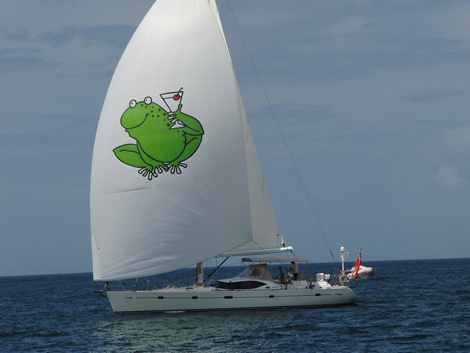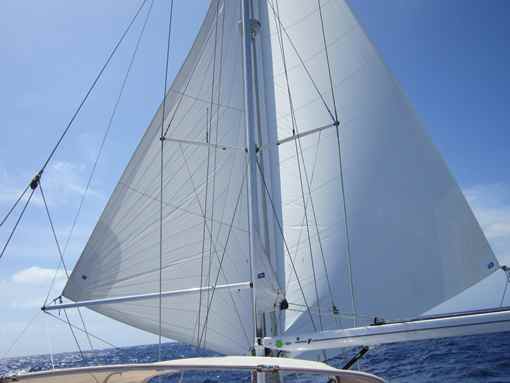From Frog to Barn Door

Sunday 18th March: The South Pacific Ocean 08 35.1S 131 09.1W Today’s second Blog by Peter (Time zone UTC -8) Various blogs in the past have referred to "the frog" and or "the barn door". For those non-sailor followers of our escapades, and because there is no other news of note, I thought it might be worthwhile describing our two main sail configurations in more detail. The Frog This is a three sided asymmetrical sail. (the sides are different lengths; the luff (the front edge) is longer than the leech (the back edge)).
This is a light weather sail. It is attached to the boat at only 3 points - the tack (bottom front corner ) is attached to the downhaul at the bow of the boat, the clew (bottom back corner) is attached to its sheet (rope) led to a block (pulley) at the stern (back of the boat) then inboard to a winch in the cockpit and finally the head (top) is attached to its halyard and pulled to the top of the mast. The downhaul leads through "the prodder", a carbon fibre pole stuck about 1/2 metre out the front then back through various blocks (pulleys) to another cockpit winch (two each side). The frog also has a snuffer - imagine a large sock that one pulls over the sail in order to pack it away - with an up and down rope. Finally the sheet sometimes needs a "barber haul" (a pulley on a rope) to stop it chafing on some other line. Sail twitchers spend endless hours adjusting the downhaul and sheet to get optimum performance. The Barn Door The Frog Sail is too delicate for stronger winds so when the wind gets up we need something more substantial. We use two headsails poled out either side of the boat. We refer to this rig affectionately as “The Barn Door”.
Barn Door because this rig is pretty much bomb-proof provided all of the string stays attached (if it doesn’t then the whole rig falls onto the foredeck and makes a terrible clatter!! – Blogs Passim). These Headsails have the same corners but are made of much thicker material and are attached to and supported by the forestay all the way up the luff. They do this by running up a groove in the forestay. The tack attaches to the foot of the furler while two sheets are attached to each clew (so it can be run out either side). Our forestay has two grooves in it enabling two headsails two be flown at the same time. When flying, one headsail (the smaller) is led through a pulley on the end of the pole then inboard through a block and on to winch. The other headsail is led through a pulley on the end of the boom then inboard to a winch. When the Barn Door is not in use, we use the furler simply to roll up the forestay and both sails can thus be suitably rolled up and packed away. Spinnaker Pole This is a pole going out from the mast held fixed in space. One end of the pole is fixed to the mast on a sliding track so it can be moved up or down, the other end held up by the uphaul (to the top of the mast), and braced by an after guy pulling aft and forward by the downhaul, both latter lines coming back to cockpit vicinity (by now we have run out of winches!) Transfer from the Frog to the Barn Door Sail changes – in either direction - are a logistical night mare. Imagine the frog flying high on the prodder, and the mainsail is out (same side as frog). The true wind is gusting to 20 knots and the Skipper calls for a sail change. This is what needs to happen: 1) Ease boom gybe preventer while letting boom out as far as possible. 2) Turn boat downwind so spinnaker collapses behind the mainsail (let out in 1) above) 3) Snuff spinnaker by pulling appropriate rope, hoping it has not tangled at the top, to pull the sock down and “snuff” the spinnaker. 4) As it nears the bottom ease the downhaul and sheet so the last bit of the sail can be snuffed. You now have a 27 metre sausage of sail waving in stiff breeze – wafting in and out behind the mainsail. 5) Drop the halyard a few feet so foot of the Frog sail is at deck level. 6) Unclip downhaul - attach to rail, do not drop in water 7) Attach short rope to clew - it has disconcerting habit of disappearing up the snuffer otherwise. 8) Detach sheet from clew. Again do not drop in water. 9) At this point Bob disappears down the fore-hatch taking the foot of sail (and snuffer bucket with him). 10) Lower sausage down black hole, never sure what happens down there apart from cries of “wait”, “ok”.... In the meantime maintain tension on the loose snuffer line as without this, it tends to wrap round radar (easy to flick off) or steaming light (where it jams). 11) Detach and stow halyard when head of sail back at deck and pass all remains below. The Frog Sails is now stowed. Next is to erect the pole to brace the Barn Door. If you are lucky, uphaul, guy and downhaul still attached (tied on) from last time so all you need to do is: 12) Unclip pole from mast. 13) Juggle pole uphaul (holds the out board end which is going up) and the end of the boom on the mast (coming down) so end of pole can be walked forward to the forestay. 14) Feed sheet from small headsail through pulley on end of pole lead back to come inboard midships then up to winch. 15) Adjust vertical position of pole then swing back with guy, easing downhaul as necessary. Brace the pole fore and aft. 16) Meanwhile on the boom side feed the larger headsail sheet through block at end of the mainsail boom. Again if you are lucky this has already happened, otherwise boom has to be brought inboard to reach. Bring inboard through block and up to winch. 17) last look round...to make sure there is nothing in the wrong place – or no ropes under or over where they should be. 18) winch in sheets while unfurling the twin headsails 19) attach barber hauler to sheet to allow free run at boom end. 20) ease gybe preventer while bringing in boom (via mainsheet) to bring mainsail off spreaders 21) roll away mainsail if desired. Job done! With a slick team, in the light, everything possible done up front, and no hang-ups - 30 minutes. In the dark with challenges at least an hour. Who says we don’t have fun? |

